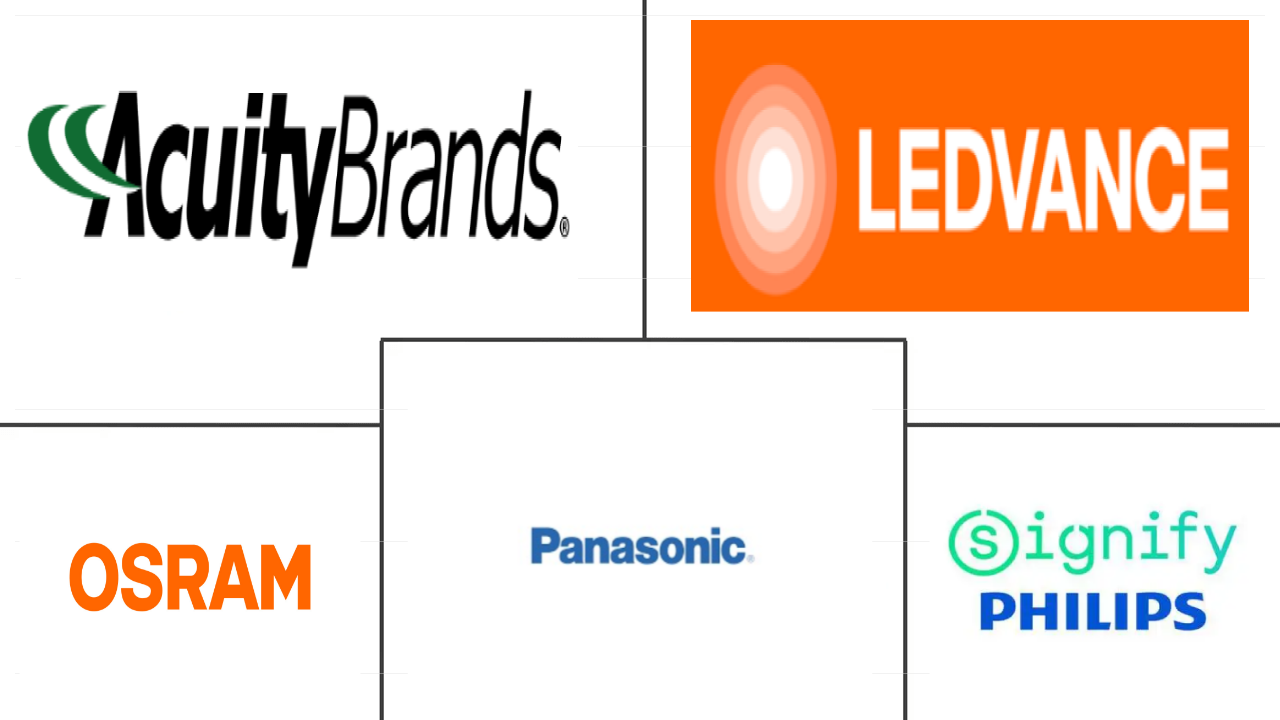Market Size of led lighting Industry
| Icons | Lable | Value |
|---|---|---|
|
|
Study Period | 2017 - 2030 |
|
|
Market Size (2024) | USD 46.54 Billion |
|
|
Market Size (2030) | USD 65.13 Billion |
|
|
Largest Share by Indoor Lighting | Industrial and Warehouse |
|
|
CAGR (2024 - 2030) | 5.76 % |
|
|
Largest Share by Region | Asia-Pacific |
|
|
Market Concentration | Low |
Major Players |
||

|
||
|
*Disclaimer: Major Players sorted in no particular order |
LED Lighting Market Analysis
The LED Lighting Market size is estimated at 46.54 billion USD in 2024, and is expected to reach 65.13 billion USD by 2030, growing at a CAGR of 5.76% during the forecast period (2024-2030).
46.54 Billion
Market Size in 2024 (USD)
65.13 Billion
Market Size in 2030 (USD)
2.15 %
CAGR (2017-2023)
5.76 %
CAGR (2024-2030)
Largest Segment by Automotive Vehicle Lighting
76.78 %
value share, Passenger Cars, 2023
The total sales of LED in this category were expected to reach 6689.3 million by the end of 2023. About 57.5 million passenger cars were sold worldwide in 2022, a YOY increase of 1.9%.
Largest Segment by Indoor Lighting
49.17 %
value share, Industrial and Warehouse, 2023
In 2022, Costco had sales of about USD 222.7 billion and operated a total of 847 warehouses leading the expected LED volume sale to reach 198.8 million by 2023.
Largest Segment by Outdoor Lighting
60.24 %
value share, Public Places, 2023
The total sales of LED in this category were expected to reach 6422.5 million by the end of 2023 owing to the GDP contribution of the manufacturing segment and Industry 4.0.
Largest Segment by Region
41.08 %
value share, Asia-Pacific, 2023
APAC is the largest region, amounting to 40.38% of the population. The APAC region is a diverse mix of rapidly emerging and developed countries that share a large interconnected road network.
Leading Market Player
11.29 %
market share, Signify (Philips), 2022

To counter aggressive commercialization by Asian players, Signify's strategy includes the creation of phased products (such as B-brand and private label).
The increasing demand for industrial production, rising need for storage space, and increasing availability of office space drive the demand for indoor LED lighting market in the region
- In terms of value share, in 2023, industrial and warehouse (I&W) accounted for the majority of the share (49.2%), followed by commercial (31.1%), residential (17.5%), and agricultural. The market share is expected to gain in (I&W) and agricultural lighting in coming years and a small reduction in the remaining divisions. Across the globe, industries faced several internal and external headwinds during COVID-19. A large number of countries sustained their industrial production in 2021. In 2021, the United States produced a total of USD 2,497.1 billion, an increase of 11.55% compared to 2020. During the same period, the UK produced a total of USD 274.87 billion, an increase of 16.57% compared to 2020. Thus, the growing industrial production resulted in creating more need for warehouses and increasing the demand for indoor lighting in coming years.
- Government subsidies and housing schemes play a key role in the adoption of new houses in many nations. In India, the government has introduced several energy-saving programs. For example, the central government's ambitious Pradhan Mantri Awas Yojana (PMAY) program aimed to build 20 million affordable metropolitan housing units nationwide by 2022. In Calgary, Canada, under multi-units, home projects fueled 17,306 starts in 2022.
- E-commerce and the export boom have led to demand for new warehouses and other logistics infrastructure, and logistics-related building is becoming an increasingly important sector. In July 2022, Yum China Holdings Inc. commenced the construction of the Yum China Supply Chain Management Center in Shanghai's Jiading district, with an area of 61,000 square meters. Such instances are expected to drive the growth of the global indoor LED market.
Government tax policies, increase in renewable projects and investment in streetlights lead to market demand
- In terms of value and volume share, Asia-Pacific accounts for the majority of the share in 2023, and North America stands at the second spot. In APAC countries, energy saving and tax benefits are a key trend gaining popularity in the industrial and commercial LED lighting market. The Indonesian government issued a 2015 Government Regulation No. 18, a series of preferential tax policies to attract domestic and foreign investment for LED, thereby providing low-cost consumer purchases. Japan planned to implement Japan’s Intended Nationally Determined Contributions (INDCs) draft to achieve at least a 50% reduction of global GHG emissions by 2050. The government encouraged citizens to proactively run NPOs and local outreach projects to raise energy-saving awareness. APAC region is increasingly investing in renewable energy projects and lighting infrastructure. In February 2023, a large-scale smart infrastructure project was initiated in Huanggang City, China, to save energy costs.
- In North America, in 2021, the United States imported approximately USD 12.5 billion worth of lighting fixtures and fittings from the rest of the world. In December 2022, 62% of builders incentivized buyers, including providing mortgage rate buy-downs for residential sales. Such a step was taken due to dropping sales activity in 2022. The sale is expected to regain its position in 2023, providing LED lighting demand significantly. Investments in connected streetlights are one of the major factors driving the market for LED lighting in the region. Numerous communities have already benefited from street and roadway lighting projects. For instance, Grand Rapids city council members approved a USD 9.46 million contract in February 2021 to upgrade all of the city's street lights to LEDs.
LED Lighting Industry Segmentation
Agricultural Lighting, Commercial, Industrial and Warehouse, Residential are covered as segments by Indoor Lighting. Public Places, Streets and Roadways, Others are covered as segments by Outdoor Lighting. Daytime Running Lights (DRL), Directional Signal Lights, Headlights, Reverse Light, Stop Light, Tail Light, Others are covered as segments by Automotive Utility Lighting. 2 Wheelers, Commercial Vehicles, Passenger Cars are covered as segments by Automotive Vehicle Lighting. Asia-Pacific, Europe, Middle East and Africa, North America, South America are covered as segments by Region.
- In terms of value share, in 2023, industrial and warehouse (I&W) accounted for the majority of the share (49.2%), followed by commercial (31.1%), residential (17.5%), and agricultural. The market share is expected to gain in (I&W) and agricultural lighting in coming years and a small reduction in the remaining divisions. Across the globe, industries faced several internal and external headwinds during COVID-19. A large number of countries sustained their industrial production in 2021. In 2021, the United States produced a total of USD 2,497.1 billion, an increase of 11.55% compared to 2020. During the same period, the UK produced a total of USD 274.87 billion, an increase of 16.57% compared to 2020. Thus, the growing industrial production resulted in creating more need for warehouses and increasing the demand for indoor lighting in coming years.
- Government subsidies and housing schemes play a key role in the adoption of new houses in many nations. In India, the government has introduced several energy-saving programs. For example, the central government's ambitious Pradhan Mantri Awas Yojana (PMAY) program aimed to build 20 million affordable metropolitan housing units nationwide by 2022. In Calgary, Canada, under multi-units, home projects fueled 17,306 starts in 2022.
- E-commerce and the export boom have led to demand for new warehouses and other logistics infrastructure, and logistics-related building is becoming an increasingly important sector. In July 2022, Yum China Holdings Inc. commenced the construction of the Yum China Supply Chain Management Center in Shanghai's Jiading district, with an area of 61,000 square meters. Such instances are expected to drive the growth of the global indoor LED market.
| Indoor Lighting | |||||
| Agricultural Lighting | |||||
| |||||
| Industrial and Warehouse | |||||
| Residential |
| Outdoor Lighting | |
| Public Places | |
| Streets and Roadways | |
| Others |
| Automotive Utility Lighting | |
| Daytime Running Lights (DRL) | |
| Directional Signal Lights | |
| Headlights | |
| Reverse Light | |
| Stop Light | |
| Tail Light | |
| Others |
| Automotive Vehicle Lighting | |
| 2 Wheelers | |
| Commercial Vehicles | |
| Passenger Cars |
| Region | |
| Asia-Pacific | |
| Europe | |
| Middle East and Africa | |
| North America | |
| South America |
LED Lighting Market Size Summary
The LED lighting market is poised for significant growth, driven by increasing demand across various sectors such as industrial, commercial, residential, and agricultural lighting. The industrial and warehouse segment currently holds the largest market share, with expectations of continued expansion in this area. The market is also witnessing a shift towards more energy-efficient solutions, supported by government initiatives and subsidies aimed at promoting energy conservation. The rise in e-commerce and logistics infrastructure further fuels the demand for LED lighting, as new warehouses and logistics centers require advanced lighting solutions. The Asia-Pacific region leads in market share, benefiting from energy-saving policies and investments in renewable energy projects, while North America follows closely, with a focus on connected streetlight investments.
The global push towards energy efficiency and sustainable construction is a key driver for the LED lighting market. Despite challenges posed by the COVID-19 pandemic, investments in energy-efficient buildings have surged, creating a greater need for LED lighting solutions. The automotive industry's shift towards electric vehicles is also contributing to market growth, as these vehicles require more advanced lighting systems. The market is characterized by fragmentation, with major players like ACUITY BRANDS INC., LEDVANCE GmbH, OSRAM GmbH, Panasonic Holdings Corporation, and Signify (Philips) holding significant shares. Recent product launches, such as Signify's Philips Smart LED bulbs and Osram's OSLON Optimum family of LEDs, highlight ongoing innovation and competition within the market.
LED Lighting Market Size - Table of Contents
-
1. MARKET SEGMENTATION (includes market size in Value in USD and Volume, Forecasts up to 2030 and analysis of growth prospects)
-
1.1 Indoor Lighting
-
1.1.1 Agricultural Lighting
-
1.1.2 Commercial
-
1.1.2.1 Office
-
1.1.2.2 Retail
-
1.1.2.3 Others
-
-
1.1.3 Industrial and Warehouse
-
1.1.4 Residential
-
-
1.2 Outdoor Lighting
-
1.2.1 Public Places
-
1.2.2 Streets and Roadways
-
1.2.3 Others
-
-
1.3 Automotive Utility Lighting
-
1.3.1 Daytime Running Lights (DRL)
-
1.3.2 Directional Signal Lights
-
1.3.3 Headlights
-
1.3.4 Reverse Light
-
1.3.5 Stop Light
-
1.3.6 Tail Light
-
1.3.7 Others
-
-
1.4 Automotive Vehicle Lighting
-
1.4.1 2 Wheelers
-
1.4.2 Commercial Vehicles
-
1.4.3 Passenger Cars
-
-
1.5 Region
-
1.5.1 Asia-Pacific
-
1.5.2 Europe
-
1.5.3 Middle East and Africa
-
1.5.4 North America
-
1.5.5 South America
-
-
LED Lighting Market Size FAQs
How big is the Global LED Lighting Market?
The Global LED Lighting Market size is expected to reach USD 46.54 billion in 2024 and grow at a CAGR of 5.76% to reach USD 65.13 billion by 2030.
What is the current Global LED Lighting Market size?
In 2024, the Global LED Lighting Market size is expected to reach USD 46.54 billion.

